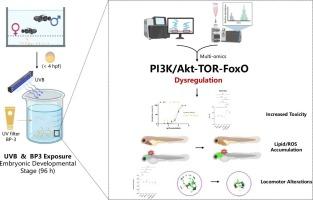氧苯酮和UVB联合暴露可诱导马尾对虾胚胎和幼虫代谢和神经失调
IF 11.3
1区 环境科学与生态学
Q1 ENGINEERING, ENVIRONMENTAL
引用次数: 0
摘要
防晒霜的广泛使用已经污染了含有氧苯酮(BP-3)等紫外线过滤器的水生环境,氧苯酮在水生生物中充当内分泌干扰物,在紫外线辐射下表现出更强的毒性。本研究采用多组学方法整合了从基因到整个生物体的反应,研究了BP-3在海鱼chulae胚胎中的uvb增强毒性。结果表明,UVB显著增强了BP-3的毒性,将LC50从5674 μg L⁻¹降低到3653 μg L⁻¹,并损害了关键的发育终点:自发运动、心率和身体长度。值得注意的是,BP-3与M. chulae的er表现出适度的结合亲和力,并破坏雌激素信号,同时在联合暴露下通过PI3K/Akt-TOR-FoxO信号轴驱动能量失调。具体而言,PI3K/Akt下调可减少能量供应,引发脂质积累;事实上,TOR上调通过异常重编程加重了代谢负担。自噬基因的抑制阻碍了脂滴和细胞器的清除,加剧了代谢功能障碍和氧化应激。ROS的积累,伴随着神经紊乱,如乙酰胆碱酯酶活性升高,神经功能受损,最终表现为游泳距离、速度和活动持续时间的减少。这些发现表明,UVB和BP-3共同暴露会导致代谢失调、氧化损伤和神经毒性,这凸显了在气候驱动的紫外线增强下,紫外线过滤器在水生生态系统中日益增长的生态毒理学风险。本文章由计算机程序翻译,如有差异,请以英文原文为准。

Combined oxybenzone and UVB exposure induces metabolic and neural dysregulation in Mugilogobius chulae embryos and larvae
The widespread use of sunscreens has contaminated aquatic environments with UV filters like oxybenzone (BP-3), which act as endocrine disruptors in aquatic organisms and exhibit enhanced toxicity under UV radiation. This study employed a multi-omics approach integrating responses from genes to whole organisms to investigate UVB-potentiated toxicity of BP-3 in embryos of the marine fish Mugilogobius chulae. Results demonstrated that UVB significantly amplified BP-3 toxicity, reducing LC50 from 5674 μg L⁻¹ to 3653 μg L⁻¹ and impairing key developmental endpoints: spontaneous movement, heart rate, and body length. Notably, BP-3 exhibited moderate binding affinity to ERs of M. chulae, and disrupted estrogen signaling, concurrently driving energy dysregulation via the PI3K/Akt-TOR-FoxO signaling axis under combined exposure. Specifically, PI3K/Akt downregulation reduced energy supply, triggering lipid accumulation; indeed, TOR upregulation exacerbated metabolic burden through abnormal reprogramming. The suppression of autophagy genes hindered the clearance of lipid droplets and organelles, fueling metabolic dysfunction and oxidative stress. ROS accumulation, along with neural disruptions like elevated AChE activity, compromised neural function, ultimately exhibited a decrease in swimming distance, speed, and activity duration. These findings established that UVB and BP-3 co-exposure drove metabolic dysregulation, oxidative damage, and neurotoxicity—highlighting the growing ecotoxicological risks of UV filters in aquatic ecosystems under climate-driven UV intensification.
求助全文
通过发布文献求助,成功后即可免费获取论文全文。
去求助
来源期刊

Journal of Hazardous Materials
工程技术-工程:环境
CiteScore
25.40
自引率
5.90%
发文量
3059
审稿时长
58 days
期刊介绍:
The Journal of Hazardous Materials serves as a global platform for promoting cutting-edge research in the field of Environmental Science and Engineering. Our publication features a wide range of articles, including full-length research papers, review articles, and perspectives, with the aim of enhancing our understanding of the dangers and risks associated with various materials concerning public health and the environment. It is important to note that the term "environmental contaminants" refers specifically to substances that pose hazardous effects through contamination, while excluding those that do not have such impacts on the environment or human health. Moreover, we emphasize the distinction between wastes and hazardous materials in order to provide further clarity on the scope of the journal. We have a keen interest in exploring specific compounds and microbial agents that have adverse effects on the environment.
 求助内容:
求助内容: 应助结果提醒方式:
应助结果提醒方式:


